
Bogense is a town in central Denmark, located on Funen in Nordfyn municipality, Region of Southern Denmark. The town has a population of 4,060. With its half-timbered houses, narrow streets and large marina, it is a popular tourist spot in the summer. The town is connected to Odense and Middelfart via buses operated by Fynbus.

Johan Otto von Spreckelsen was a Danish architect, best known for designing the Grande Arche of La Défense in Puteaux, near Paris. He directed the creation of several modern churches in Denmark.

The Church of Our Lady is the Lutheran cathedral of Copenhagen. It is situated on the Frue Plads public square in central Copenhagen, next to the historic main building of the University of Copenhagen.

Esbjerg is a seaport city and seat of Esbjerg Municipality on the west coast of the Jutland peninsula in southwest Denmark. By road, it is 71 kilometres (44 mi) west of Kolding and 164 kilometres (102 mi) southwest of Aarhus. With an urban population of 71,505 it is the fifth-largest city in Denmark, and the largest in West Jutland.

St. Peter's Church is located at Næstved on the Danish island of Zealand. St. Peter's is situated in the Næstved parish of the Diocese of Roskilde of the Church of Denmark. The church is one of Denmark's foremost Gothic buildings.

St. Ib's Church, 3 km south-west of Svaneke on the Danish island of Bornholm, is a fine 12th century Romanesque building. The altarpiece was painted by Christoffer Wilhelm Eckersberg in 1846. The Renaissance pulpit was decorated by Paul Høm in 1964 with ceramics of the four evangelists.

Rolf Saenger Graae was a Danish architect who is remembered for the churches and religious works he completed or restored in the style of the Klint school. He is also considered to be Denmark's most important 20th century organ designer.

St. Peter's Church is a Romanesque parish church some 6 km east of Aakirkeby on the Danish island of Bornholm. It is thought to be the oldest church on the island.
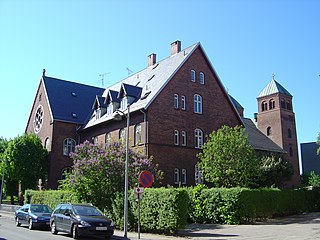
St. Anne's Church is a Roman-Catholic church in Sundby on Amager in Copenhagen, Denmark. It is located just off Amagerbrogade, next to Eberts Villaby. The church is closely affiliated with the nearby St. Ann's School.
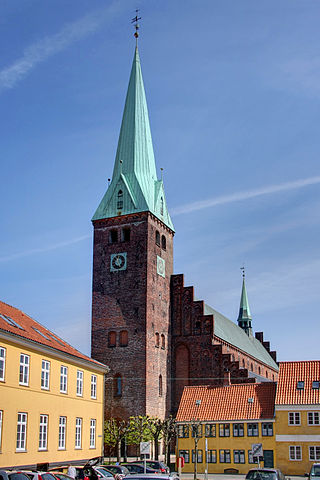
Saint Olaf's Church is the cathedral church of Helsingør in the north of Zealand, Denmark. With a history going back to around 1200, the present building was completed in 1559. In 1961, the church was given the status of cathedral in connection with the establishment of the Diocese of Helsingør.
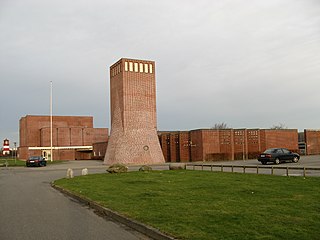
Sædden Church is a church of the Church of Denmark in Esbjerg in the southwest of Jutland, Denmark. Designed by Inger and Johannes Exner, the almost cube-shaped building with a tall, free-standing bell tower was completed and consecrated in 1978.
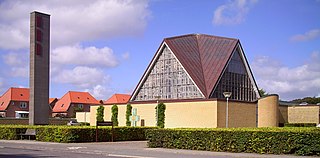
Trinity Church is a modern church in Esbjerg in the southwest of Jutland, Denmark. Designed by local architects Erik Flagstad Rasmussen and Knud Thomsen, the yellow-brick building with large triangular stained-glass windows was completed in 1961.

Gjesing Church, also Gesing Church, is a modern church in Esbjerg in the southwest of Jutland, Denmark. Designed by architects Niels Munk and Keld Wohlert, the red-brick building with a steeply pitched roof was completed in 1983.

Ledreborg is a palatial mansion near Lejre, 12 km (7.5 mi) to the southwest of Roskilde on the Danish island of Zealand. Today's Baroque building was completed in 1746 by Minister of State Johan Ludvig Holstein (1694–1763) who commissioned J.C. Krieger to carry out the work.

St Ib's Church is a Romanesque church in Roskilde on the Danish island of Zealand. It was first mentioned in 1291. The church was once richly decorated with frescos.

Saint Jørgensbjerg Church is a historic church in Roskilde on the Danish island of Zealand. With a nave and chancel in travertine limestone dating from c. 1080, it is Denmark's oldest preserved stone building.
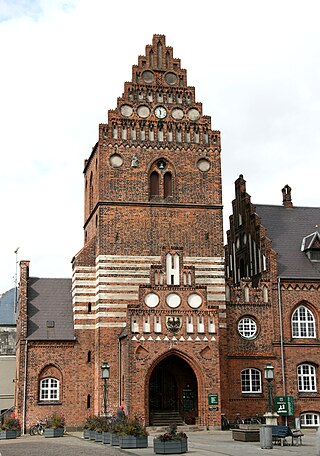
The Sankt Laurentii Church Mama Tower is all that remains of Sankt Laurentii Church in Roskilde on the Danish island of Zealand. The church itself was built of travertine in the Romanesque style in the 13th century but was torn down after the Reformation leaving only the tower from the beginning of the 16th century. The tower now forms part of the former town hall. It contains a museum where archaeological finds from 1998 can be seen.
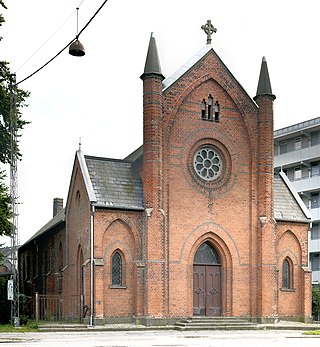
Saint Nikolaj Church is a church in Aarhus, Denmark. The church is situated in the Indre by neighbourhood on the western edge of the City Hall Park and was completed in 1893 from a design by Emanuel Edvard Christie Fleischer and Hjalmar Kjær in the Neo-Romanesque style. Saint Nikolaj Church is today owned and operated by the Catholic Church in Denmark and home to the local Chaldean congregation in Aarhus. The church is 700 square meters and holds 28 benches which can seat up to 300 people.
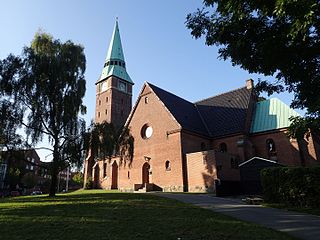
St. John's Church is a congregation of the Church of Denmark in Aarhus, Denmark. The parish church is situated in the Trøjborg neighbourhood, immediately north-west of Nordre Cemetery. In 2015, Saint Johannes Parish counted some 8,916 members.

Åbyhøj Church is a church in Aarhus, Denmark. The church is situated in the western Åbyhøj neighbourhood on Silkeborgvej. Åbyhøj Church is a parish church within the Church of Denmark, the Danish state church, under the Diocese of Aarhus. It is a parish church in the Åby Parish along with Åby Church and serves some 11.000 parish members.





















